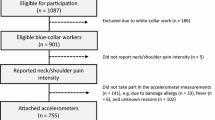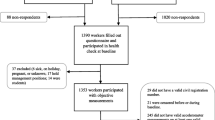Abstract
Objective
This study aimed to investigate the causal relationship between daily walking steps and the 1-year incidence of neck and low back pain in workers with sedentary jobs.
Methods
A 1-year prospective study was carried out among 387 workers who reported no spinal symptoms in the previous 3 months with pain intensity greater than 30 mm on a 100-mm visual analog scale. Data were gathered using a self-administered questionnaire, physical examination, and pedometer. Follow-up data were collected every month for the incidence of musculoskeletal disorders and every 3 months for daily walking steps. Two regression models were built to analyze the effect of daily walking steps on the 1-year incidence of neck and low back pain.
Results
Among 367 (95 %) participants followed for 1 year, 16 and 14 % reported incident neck and low back pain, respectively. After adjusting for confounders, a negative association between daily walking steps and onset of neck pain was found. Increasing daily walking steps by 1,000 reduced the risk of neck pain by 14 %. No significant association between daily walking steps and the onset of low back pain was found.
Conclusions
Increasing daily walking steps is a protective factor for onset of neck pain in those with sedentary jobs. Interventions to reduce neck pain should include attempts to increase daily walking steps.

Similar content being viewed by others
References
Allender S, Foster C, Scarborough P, Rayner M (2007) The burden of physical activity-related ill health in the UK. J Epidemiol Community Health 61:344–348
Nguyen HQ, Ackermann RT, Berke EM et al (2007) Impact of a managed-medicare physical activity benefit on health care utilization and costs in older adults with diabetes. Diabetes Care 30:43–48
Holth HS, Werpen HKB, Zwart JA, Hagen K (2008) Physical inactivity is associated with chronic musculoskeletal complaints 11 years later: results from the Nord-Trøndelag health study. BMC Musculoskelet Disord 9:159
Croft PR, Lewis M, Papageorgiou AC et al (2001) Risk factors for neck pain: a longitudinal study in the general population. Pain 93:317–325
Walker BF (2000) The prevalence of low back pain: a systematic review of the literature from 1966 to 1998. J Spinal Disord 13:205–217
Guo HR, Chang YC, Yeh WY et al (2004) Prevalence of musculoskeletal disorder among workers in Taiwan: a nationwide study. J Occup Health 46:26–36
van den Heuvel SG, Ijmker S, Blatter BM, de Korte EM (2007) Loss of productivity due to neck/shoulder symptoms and hand/arm symptoms: results from the PROMO-study. J Occup Rehabil 17:370–382
Sitthipornvorakul E, Janwantanakul P, Purepong N et al (2011) The association between physical activity and neck and low back pain: a systematic review. Eur Spine J 20:677–689
Côté P, Van der Velde G, Cassidy JD et al (2008) The burden and determinants of neck pain in workers. Results of the bone and joint decade 2000–2010 task force on neck pain and its associated disorders. Spine 33:S60–S74
Rasmussen-Barr E, Bohman T, Hallqvist J et al (2013) Do physical activity level and body mass index predict recovery from persistent neck pain in men and women of working age? A population-based cohort study. Eur Spine J 22:2077–2083
van Hooff ML, Spruit M, O’Dowd JK et al (2014) Predictive factors for successful clinical outcome 1 year after an intensive combined physical and psychological programme for chronic low back pain. Eur Spine J 23:102–112
Bravata DM, Smith-Spangler C, Sundaram V et al (2007) Using pedometers to increase physical activity and improve health: a systematic review. JAMA 298:2296–2304
Phakthongsuk P (2009) Construct validity of the Thai version of the job content questionnaire in a large population of heterogeneous occupations. J Med Assoc Thai 92:564–572
Ming Z, Narhi M, Siivola J (2004) Neck and shoulder pain related to computer use. Pathophysiology 11:51–56
Janssen I, Katzmarzyk PT, Ross R (2002) Body mass index, waist circumference, and health risk: evidence in support of current National Institutes of Health guidelines. Arch Intern Med 162:2074–2079
Tousignant M, de Bellefeuille L, O’Donoughue S et al (2000) Criterion validity of the cervical range of motion (CROM) goniometer for cervical flexion and extension. Spine 25:324–330
Tousignant M, Duclos E, Lafleche S et al (2002) Validity study for the cervical range of motion device used for lateral flexion in patients with neck pain. Spine 27:812–817
Tousignant M, Smeesters C, Breton AM et al (2006) Criterion validity study of the cervical range of motion (CROM) device for rotational range of motion on healthy adults. J Orthop Sports Phys Ther 36:242–248
Clare HA, Adams R, Maher CG (2007) Construct validity of lumbar extension measures in McKenzie’s derangement syndrome. Man Ther 12:328–334
Harris KD, Heer DM, Roy TC et al (2005) Reliability of a measurement of neck flexor muscle endurance. Phys Ther 85:1349–1355
Tekin Y, Ortancil O, Ankarali H et al (2009) Biering-Sorensen test scores in coal miners. Joint Bone Spine 76:281–285
Kuorinka I, Jonsson B, Kilbom A et al (1987) Standardised Nordic questionnaires for the analysis of musculoskeletal symptoms. Appl Ergon 18:233–237
Fleiss JL (2011) Design and analysis of clinical experiments. Wiley, New York
Rothman KJ, Greenland S (1998) Modern Epidemology, 2nd edn. Lippincott-Raven, Philadelphia
Wahlström J (2005) Ergonomics, musculoskeletal disorders and computer work. Occup Med 55:168–176
Miller R, Brown W (2004) Meeting physical activity guidelines and average daily steps in a working population. J Phys Act Health 1:218–226
Schmidt MD, Cleland VJ, Shaw K et al (2009) Cardiometabolic risk in younger and older adults across an index of ambulatory activity. Am J Prev Med 37:278–284
Steele R, Mummery K (2003) Occupational physical activity across occupational categories. J Sci Med Sport 6:398–407
Hush JM, Michaleff Z, Maher CG, Refshauge K (2009) Individual, physical and psychological risk factors for neck pain in Australian office workers: a 1-year longitudinal study. Eur Spine J 18:1532–1540
Korhonen T, Ketola R, Toivonen R et al (2003) Work related and individual predictors for incident neck pain among office employees working with video display units. Occup Environ Med 60:475–482
Juul-Kristensen B, Sogaard K, Stroyer J et al (2004) Computer users’ risk factors for developing shoulder, elbow and back symptoms. Scand J Work Environ Health 30:390–398
Pedersen MT, Blangsted AK, Andersen LL et al (2009) The effect of worksite physical activity intervention on physical capacity, health, and productivity: a 1-year randomized controlled trial. J Occup Environ Med 51:759–770
Ariëns GA, Bongers PM, Douwes M et al (2001) Are neck flexion, neck rotation, and sitting at work risk factors for neck pain? Results of a prospective cohort study. Occup Environ Med 58:200–207
Heneweer H, Picavet HS, Staes F et al (2012) Physical fitness, rather than self-reported physical activities, is more strongly associated with low back pain: evidence from a working population. Eur Spine J 21:1265–1272
O’Sullivan PB, Mitchell T, Bulich P et al (2006) The relationship between posture and back muscle endurance in industrial workers with flexion-related low back pain. Man Ther 11:264–271
Acknowledgments
This work was funded by Chulalongkorn University Centenary Academic Development Project (#12).
Conflict of interest
None.
Author information
Authors and Affiliations
Corresponding author
Rights and permissions
About this article
Cite this article
Sitthipornvorakul, E., Janwantanakul, P. & Lohsoonthorn, V. The effect of daily walking steps on preventing neck and low back pain in sedentary workers: a 1-year prospective cohort study. Eur Spine J 24, 417–424 (2015). https://doi.org/10.1007/s00586-014-3577-3
Received:
Revised:
Accepted:
Published:
Issue Date:
DOI: https://doi.org/10.1007/s00586-014-3577-3




